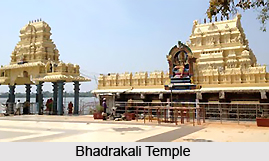 History of Bhadra kali Temple covers the religious evolution in Telangana and Andhra Pradesh. This temple of historical importance was constructed by the King Pulakesin II of Chalukya dynasty around 625 A.D to celebrate his victory over Vengi region of Andhra Desham.
History of Bhadra kali Temple covers the religious evolution in Telangana and Andhra Pradesh. This temple of historical importance was constructed by the King Pulakesin II of Chalukya dynasty around 625 A.D to celebrate his victory over Vengi region of Andhra Desham.
This can be observed from the square pillars used in the temple structure which were different from the circular pillars commonly used in temples constructed by later Kakatiyas Dynasty rulers.
Kakatiya kings of "Orugallu Empire" or Warangal Empire, which was declined by the hands of the Mughals in the later phase of medieval era, which is the present Warangal town have adopted Goddess Bhadrakali as their "Kula Devatha" giving her preference over other Gods.
Near Bhadrakali Temple, there is an artificial lake, which was built later by Ganapathi Deva, a minister in Kakatiya Dynasty. A road leading to the temple was also added during that period. Due to the fall of Kakatiya Dynasty by the Sultan of Delhi, Ala-ud-din Khilji, his general Malik Kafur and later to Ghias-ud-Din Tughlaq, and during the rule of Bahamani Sultans and Golkonda rulers, the temple lost its prominence over the period and the place has become dilapidated from the 12th Century.
Sri Ganapathi Sastri a local Brahmin and Devi Upasaka (Devotee of Goddess Kali) from Karnataka has migrated to Warangal in 1940. He noticed the old Bhadrakali temple and has interest in renovating the temple. He constructed a small house next to the temple and started living in this isolated place. He along with Sri Mudumbai Ramanujacharya sought the help of Sri Maganlal Sameja, a prominent local merchant and other affluent locals and renovated the old temple in 1950.
Many persons like Brahmasri Sri Hari Radhakrishnamurthy, Adluri Seetharama Shastry, Vangala Guravaiah, Thandra Venkata Rama Narsaiah, Mahatapaswini Mangalambika and Tankasala Narasimha Rao have lent their hands in the renovation work of the temple.
Before the renovation of Bhadrakali Temple in the year 1950 there were Animal Sacrifices at the temple. It is an old custom at Kali temple. This practice was stopped from 1950 onwards after the renovation of the temple. During the renovation, Chandi Yantra was installed in the temple and "Amrutha Beejaksharas" (holy shlokas) were written on the deity`s hanging tongue and modified the deity`s fierce looking eyes and tongue to a pleasant looking face. Since then everyday pujas, Sharannavaratras, Vasantha navarathras are being conducted regularly as per the Vedic rites.
Sri Ganapathi Sastri, at the age of 113, died on 11 November 2011 in Warangal. He was survived by two sons and three daughters. He was the active member of temple trustee at the time of his death. The temple and the people of Warangal have lost a great man who has developed the temple single handedly. His son Sri B. Seshagiri Rao has taken over the temple affairs as chief priest a few years ago. This temple now gained fame as a religious site in Telangana, a newly formed state in India with capital Hyderabad for 10 years.











